|
|
|
|
|
Oil On
Canvas, Real Flavor of Old Masters
|
|

|
ARTWORKS
INDEX
A B C D E F G H I J K L M N O P Q R S T U V W X Y Z |
ARTISTS
INDEX
A B C D E F G H I J K L M N O P Q R S T U V W X Y Z |
|
|
| | |
|
|
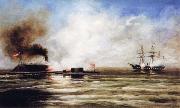 |
Xanthus Russell Smith -- Click Here
|
|
Marine, landscape, portrait, and historical painter.
American , 1839-1929
was an American artist best known for his illustrations of the American Civil War. Born in Philadelphia, Smith served in the United States Navy during the war and depicted naval battles with a variety of media, including pencil and oil paint. His best known work (right) recreates the 1864 battle between the CSS Alabama and USS Kearsarge off Cherbourg, France. Smith did not actually participate in most of the battles he illustrated; instead, he generally consulted those who were present at the engagements. |
|
|
|
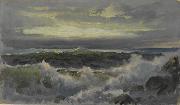 |
William Trost Richards -- Click Here
|
|
(June 3, 1833 - April 17, 1905) was an American landscape artist associated with both the Hudson River School and the American Pre-Raphaelite movement.
William Trost Richards was born on 3 June 1833 in Philadelphia. In 1846 and 1847 he attended the local Central High School. Between 1850 and 1855 he studied part-time with the German artist Paul Weber while working as designer and illustrator of ornamental metalwork. Richards first public showing was part of an exhibition in New Bedford, Massachusetts, organized by artist Albert Bierstadt in 1858. In 1862 he was elected honorary member of the National Academy of Design and Academician in 1871. In 1863, he became a member of the Association of the Advanced of Truth in Art, an American Pre-Raphaelite group. In 1866, he departed for Europe for one year. Upon his return and for the following six years he spent the summers on the East Coast. In the 1870s, he produced many acclaimed watercolor views of the White Mountains, several of which are now in the collection of the Metropolitan Museum of Art. Richards exhibited at the National Academy of Design from 1861 to 1899 and at the Brooklyn Art Association from 1863 to 1885. He was elected a full member of the National Academy in 1871.
Richards rejected the romanticized and stylized approach of other Hudson River painters and instead insisted on meticulous factual renderings. His views of the White Mountains are almost photographic in their realism. In later years, Richards painted almost exclusively marine watercolors.
His works are featured today in many important American museums, including the National Gallery, the Smithsonian American Art Museum, the Wadsworth Atheneum, the Philadelphia Museum of Art, the Yale University Art Gallery, the High Museum of Art, the Museum of Fine Arts, Boston, the Fogg Art Museum, the Brooklyn Museum of Art and the Thyssen-Bornemisza Museum.
|
|
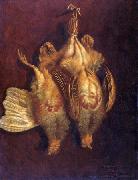 |
William Roos -- Click Here
|
|
William Roos (1808 - 4 July 1878) was a Welsh artist and engraver. Several of Roos' portraits, mainly of notable Welsh figures, are owned by the National Library of Wales.
|
|
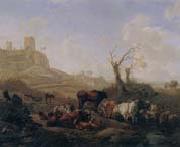 |
William Romeyn -- Click Here
|
|
Haarlem circa 1624-circa 1694
|
|
 |
William Rimmer -- Click Here
|
|
1816-1879
William Rimmer Gallery
William Rimmer (20 February 1816?C20 August 1879) was an American artist born in Liverpool, England. He was the son of a French refugee, who emigrated to Nova Scotia, where he was joined by his wife and child in 1818, and who in 1826 moved to Boston, where he earned a living as a shoemaker. The son learned the father's trade; at fifteen became a draughtsman and sign-painter; then worked for a lithographer; opened a studio and painted some ecclesiastical pictures.
In 1840 Rimmer made a tour of New England painting portraits, he lived in Randolph, Massachusetts, in 1845-1855 as a shoemaker, for the last years of the decade practising medicine; practised in East Chelsea, Massachusetts and received a diploma from the Suffolk County Medical Society and in 1855 removed to East Milton, Massachusetts where he supplemented his income by carving busts from blocks of granite.
In 1860 Rimmer made his head of St. Stephen and in 1861 his Falling Gladiator. Rimmer's sculptures, except those mentioned and The Fighting Lions, A Dying Centaur, and a statue of Alexander Hamilton (made in 1865 for the city of Boston), were soon destroyed. He worked in clay, not modelling but building up and chiselling; almost always without models or preliminary sketches; and always under technical disadvantages and in great haste; but his sculpture is anatomically remarkable and has an early Greek simplicity and strength.
Rimmer published Elements of Design (1864) and Art Anatomy (1877), but his great work was in the classroom, where his lectures were illustrated with blackboard sketches.
Rimmer's most famous work, though not normally associated with him, is Evening: Fall of Day. This paint-on-canvas portrays Apollo, and a modified version was used by Swan Song Records, the recording label founded in 1974 by English rock group Led Zeppelin, in their label art. It is often mistaken to be a picture of Icarus, Lucifer, Satan, or Daedalus |
|
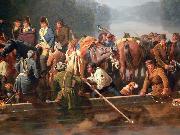 |
William Ranney -- Click Here
|
|
(May 9, 1813 - November 18, 1857) was a 19th-century American painter, known for his depictions of Western life, sporting scenery, historical subjects and portraiture. In his 20-year career, he made 150 paintings and 80 drawings, and is considered the first major genre painter to work in New Jersey, and one of the most important pre-Civil War American painters.His work is on display in several museums across the United States. One of his contemporaries opined, "A specimen of Ranney is indispensable wherever a collection of American art exists." |
|
|
|
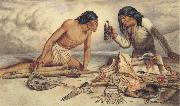 |
William George Richardson -- Click Here
|
|
artist (b at Nottingham, Eng 12 June 1833; d at Sussex, NB 18 Nov 1889) |
|
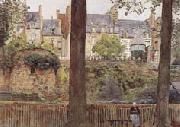 |
William Frederick Yeames,RA -- Click Here
|
|
1835-1918
English painter. The son of a British consul in Russia, Yeames was sent to school in Dresden after the death of his father in 1842. He also studied painting there. The collapse of the Yeames family fortune resulted in a move to London in 1848, where Yeames learnt anatomy and composition from George Scharf (1788-1860). He later took lessons from F. A. Westmacott. In 1852 he continued his artistic education in Florence under Enrico Pollastrini and Raphael Buonajuto, from whom he learnt the methods of the Old Masters. He drew from frescoes by Ghirlandaio, Gozzoli and Andrea del Sarto and painted in the Life School at the Grand Ducal Academy. He then went to Rome and made landscape studies and copied Old Masters, including Raphael's frescoes in the Vatican. His extensive study of Italian art gave him a precision and facility that assisted his artistic success upon his return to London in 1859. There he set up a studio in Park Place and became involved with the ST JOHN'S WOOD CLIQUE. He exhibited at the Royal Academy and the British Institution from 1859 and became an ARA in 1866. |
|
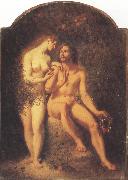 |
William Edward frost R.A. -- Click Here
|
|
1810-1877
was an English painter of the Victorian era. Virtually alone among English artists in the middle Victorian period, he devoted his practice to the portrayal of the female nude. Frost was educated in the schools of the Royal Academy, beginning in 1829; he established a reputation as a portrait painter before branching into historical and mythological subjects, including the sub-genre of fairy painting that was characteristic of Victorian art. In 1839 he won the Royal Academy's gold medal for his "Prometheus Bound," and in 1843 he won a prize in the Westminster Hall competition for his "Una Alarmed by Fauns" (a subject from Spenser's The Faerie Queen). He was elected an associate member of the Royal Academy in 1846, and a full member in 1870. Frost is widely recognized as a follower of William Etty, who preceded him as the primary British painter of nudes in the second quarter of the nineteenth century. |
|
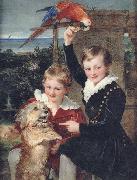 |
William Charles Ross -- Click Here
|
|
English Miniature Painter, 1794-1860
was a British painter. Early in his career, he was known for historical paintings, but he later gained fame for his miniatures and portraits. He was made a member of the Royal Academy in 1842. |
|
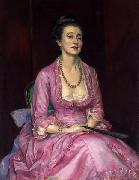 |
William Bruce Ellis Ranken -- Click Here
|
|
United Kingdom (1881- 1941 ) - Watercolours
painted Souvenir of the seventies. Signed with monogram and dated 1923 |
|
|
|
 |
Willem Roelofs -- Click Here
|
|
Dutch Painter, 1822-1897
Dutch painter. He is said to have made his first sketches at the age of four; at fifteen he completed his first landscape painting. Many of these early works are in the print rooms of the Rijksmuseum, Amsterdam, and the Gemeentemuseum, The Hague. In c. 1837-8 he was apprenticed to the amateur painter Abraham Hendrik de Winter (1800-61) in Utrecht, where the Roelofs family had moved in 1826. In 1838 he entered his first paintings in the Exhibition of Living Masters in Amsterdam and Rotterdam. In the late summer of 1840 Roelofs became a pupil of the landscape and animal painter Hendrik van de Sande Bakhuyzen (1795-1860), with whom he made a study trip to Germany in 1841. Roelofs took a special interest in nature: he applied himself energetically both to painting and drawing, almost always selecting landscape subjects. He also studied entomology and accumulated a large collection of insects. After his training he returned to his parents in Utrecht. |
|
|
|
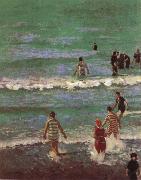 |
Walter Richard Sickert -- Click Here
|
|
British Camden Town Group Painter, 1860-1942
British painter, printmaker, teacher and writer of German birth. Sickert was one of the most influential British artists of this century. He is often called a painter painter, appealing primarily to artists working in the figurative tradition; there are few British figurative painters of the 20th century whose development can be adequately discussed without reference to Sickert subject-matter or innovative techniques. He had a direct influence on the Camden Town Group and the Euston Road School, while his effect on Frank Auerbach, Howard Hodgkin and Francis Bacon was less tangible. Sickert active career as an artist lasted for nearly 60 years. His output was vast. He may be judged equally as the last of the Victorian painters and as a major precursor of significant international developments in later 20th-century art, especially in his photo-based paintings. |
|
|
|
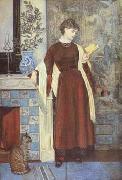 |
Walter Crane,RWS -- Click Here
|
|
1845-1915
English painter, illustrator, designer, writer and teacher. He showed artistic inclinations as a boy and was encouraged to draw by his father, the portrait painter and miniaturist Thomas Crane (1808-59). A series of illustrations to Tennyson's The Lady of Shalott (Cambridge, MA, Harvard U., Houghton Lib.) was shown first to Ruskin, who praised the use of colour, and then to the engraver William James Linton, to whom Crane was apprenticed in 1859. From 1859 to 1862 Crane learnt a technique of exact and economical draughtsmanship on woodblocks. His early illustrative works included vignette wood-engravings for John R. Capel Wise's The New Forest: Its History and its Scenery (1862). |
|
|
|
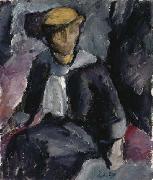 |
Valle Rosenberg -- Click Here
|
|
painted Sitting lady in 1913 |
|
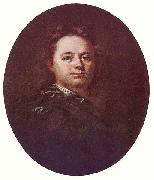 |
Vaclav Vavrinec Reiner -- Click Here
|
|
(Czech: Vaclav Vavřinec Reiner; 8 August 1686 or 1689 - 9 October 1743) was a Baroque painter who lived and died in Prague, Bohemia. |
|
 |
Tommaso Ruiz -- Click Here
|
|
Active in Naples during the second half of the 18th Century
|
|
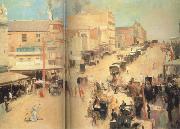 |
Tom roberts -- Click Here
|
|
British-born Australian Painter, 1856-1931
Australian painter of English birth. A leader of the HEIDELBERG SCHOOL and pioneer of plein-air Impressionism in Australia, he has been described as 'the father of Australian landscape painting'. Having moved to Melbourne in 1869, he studied at the East Collingwood and Carlton Schools of Design and the National Gallery of Victoria's School of Art (1874-81) while working as a photographic assistant. He led sketching expeditions with Frederick McCubbin and initiated student requests for reforms at the school. Returning to England, he enrolled in the Royal Academy Schools, London, on 6 December 1881, officially recommended by Edwin Long. In the summer of 1883 he toured Spain with the painter John Peter Russell. He learnt something of French Impressionism from Spanish art students Ramon Casas and Loreano Barrau (b 1864), and then followed the latter's advice to visit the Academie Julian in Paris. He returned to Melbourne in 1885 and the following year established the first summer camp at Box Hill with McCubbin and Louis Abrahams (1852-1903), portrayed in his painting the Artists' Camp (c. 1886; Melbourne, N.G. Victoria). According to the painter Arthur Streeton, it was Roberts's 'quick perception and expression of the principles of Impressionism in the year 1886, |
|
|
|
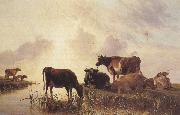 |
Thomas sidney cooper,R.A. -- Click Here
|
|
1803-1902
English painter. He was encouraged in his ambition to become an artist by Sir Thomas Lawrence and the animal painter Abraham Cooper (no relation; 1787-1868). He entered the Royal Academy Schools, London, in 1823. He subsequently taught art in Brussels where he met Eugene Verboeckhoven, whose work had a profound influence on him. Through Verboeckhoven he came to appreciate the work of such 17th-century Dutch painters as Aelbert Cuyp and Paulus Potter. In 1831 he returned to London, exhibiting at the Royal Society of British Artists. He exhibited 48 pictures at the British Institution between 1833 and 1863. The majority of his work was, however, exhibited at the Royal Academy; from 1833 to 1902 he exhibited 266 works there without a break, |
|
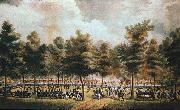 |
Thomas Ruckle -- Click Here
|
|
was a house painter and sign painter in early nineteenth century Baltimore, Maryland, and an amateur painter. He is best known for his paintings The Battle of North Point, and The Defense of Baltimore. Ruckle was a veteran of the War of 1812, in which he had served as a corporal in the 5th Maryland Regiment of the Maryland Militia.
Ruckle was born in Ireland and, having moved to Baltimore, Maryland, he became a sign painter and house painter. It is likely that he had very little, if any, formal training as an artist. |
|
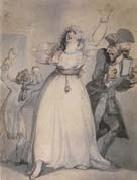 |
Thomas Rowlandson -- Click Here
|
|
English Illustrator, 1756-1827,English caricaturist, watercolourist, draughtsman and engraver. Although he is commonly thought of as a satirist, most of his drawings are gently humorous, and in some cases objective, records of urban and rustic life. With the exception of a small number of topographical drawings, they are characterized by an abundance of picaresque incidents, whether robust or sentimental, and have much in common with the novels of Laurence Sterne and Henry Fielding, which Rowlandson illustrated in 1808 and 1809. |
|
|
|
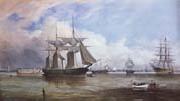 |
Thomas Robertson -- Click Here
|
|
January 9, 1829 ?C February 3, 1871,English dramatist and actor; brother of Madge Kendal. After spending several years as an actor, he turned to playwriting, initiating the ecup and saucere school of drama, which was characterized by its realism and its contemporary, domestic setting. His first successful play, David Garrick (1864), was followed by Society (1865) and Ours (1866). With Caste (1867) he began a close association with Squire Bancroft and his wife, Marie Wilton Bancroft, the actress, and they produced several of his plays. |
|
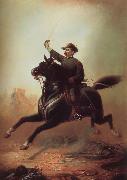 |
Thomas Buchanan Read -- Click Here
|
|
American Painter, 1822-1872,was an American poet and portrait painter born in Chester County, Pennsylvania. Read wrote a prose romance, The Pilgrims of the Great St. Bernard, and several books of poetry, including The New Pastoral, The House by the Sea, Sylvia, and A Summer Story. Some of the shorter pieces included in these, e.g., "Sheridan's Ride," "Drifting,""The Angler", "The Oath," and "The Closing Scene," have great merit. Read was briefly associated with the Pre-Raphaelite Brotherhood. His greatest artistic popularity took place in Florence. Among portraits he painted were Abraham Lincoln, Henry Longfellow, Alfred Tennyson, Elizabeth Barrett Browning, Robert Browning and William Henry Harrison. Read died from injuries sustained in a carriage accident, which weakened him and led him to contract pneumonia while on shipboard returning to America. |
|
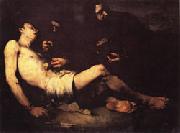 |
Theodule Ribot -- Click Here
|
|
Saint-Nicolas-d'Attez, 1823-Colombes 1891.
was a French realist painter. He was born in Saint-Nicolas-d'Attez, and studied at the École des Arts et Metiers de Chalons before moving to Paris in 1845. There he found work decorating gilded frames for a mirror manufacturer; he also studied in the studio of Auguste-Barth??l??my Glaize. After a trip to Algeria around 1848, he returned in 1851 to Paris, where he continued to make his living as an artisan. In the late 1850s, working at night by lamplight, he began to paint seriously, depicting everyday subjects in a realistic style. He made his Salon debut in 1861 with several paintings of kitchen subjects. Collectors purchased the works, and his paintings in the Salons of 1864 and 1865 were awarded medals. Ribot painted domestic genre works, still-lifes, portraits, and religious scenes. His preference was for painting directly from nature, emphasizing the contrasts of light and dark. His use of chiaroscuro to suggest psychological states grew from his admiration for Spanish and Dutch baroque masters such as Ribera and Rembrandt, an enthusiasm shared by his contemporaries Courbet and Bonvin. Members of Ribot's family are the likely models for many of his figure compositions, in which the subjects engage in humble activities, such as preparing meals or gathering in groups to read to each other. The light draws attention to faces and hands, which emerge sharply from dimly lit surroundings. Although the realism of Ribot's work aligns him with the most progressive artists of the generation preceding the Impressionists, he was no revolutionary, |
|
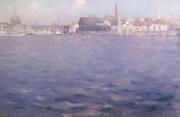 |
Theodore Roussel -- Click Here
|
|
English Painter, 1847-1926
English painter and etcher of French birth. He was born and educated in France and settled in England in 1878, when he quickly established a reputation. Largely self-taught, his few extant early paintings show an eclectic style that combines the techniques of the Old Masters, which he studied in detail, with the subject-matter of modern urban life. In 1885 he was introduced to James McNeill Whistler, his neighbour in Chelsea, London, and in consequence a lifelong friendship was formed. As Roussel was a member of Whistler's London circle his work in watercolour and oil was influenced by the latter in style and choice of subject-matter. His oft-quoted remark that he was a 'pupil of Whistler' is, however, belied by his frequently distinct style, as seen in such paintings as the Reading Girl (1886-7; London, Tate). In 1888 Whistler introduced him to the techniques of etching and drypoint, resulting in such etchings as the Sign of the 'White Horse', Parson's Green (c. 1893-4; see Rutter, pl. xxx). For the remainder of his life he relentlessly pursued the medium, even, like Whistler, designing his own special frames. Always fascinated by the theoretical and practical nature of colour science, he constantly experimented and was an early pioneer of the technique of colour etching in England, producing such works as Dawn. |
|
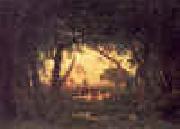 |
Theodore Rousseau -- Click Here
|
|
1812-1867
French
Theodore Rousseau Galleries
Rousseau's pictures are always grave in character, with an air of exquisite melancholy which is powerfully attractive to the lover of landscapes. They are well finished when they profess to be completed pictures, but Rousseau spent so long a time in working up his subjects that his absolutely completed works are comparatively few. He left many canvases with parts of the picture realized in. detail and with the remainder somewhat vague; and also a good number of sketches and water-color drawings. His pen work in monochrome on paper is rare; it is particularly searching in quality. There are a number of fine pictures by him in the Louvre, and the Wallace collection. contains one of his most important Barbizon pictures. There is also an example in the Ionides collection at the Victoria and Albert Museum. |
|
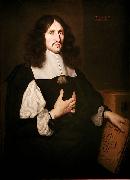 |
Theodore Roos -- Click Here
|
|
Theodore "Teddy" Roosevelt, October 27, 1858 - January 6, 1919, was the 26th President of the United States (1901-1909). He is noted for his exuberant personality, range of interests and achievements, and his leadership of the Progressive Movement, as well as his "cowboy" persona and robust masculinity. He was a leader of the Republican Party and founder of the short-lived Progressive ("Bull Moose") Party of 1912. Before becoming President, he held offices at the city, state, and federal levels. Roosevelt's achievements as a naturalist, explorer, hunter, author, and soldier are as much a part of his fame as any office he held as a politician. |
|
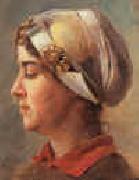 |
Theodore Robinson -- Click Here
|
|
1852-1896
Theodore Robinson (July 3, 1852 ?C April 2, 1896) was an American painter best known for his impressionist landscapes. He was one of the first American artists to take up impressionism in the late 1880s, visiting Giverny and developing a close friendship with Claude Monet. Several of his works are considered masterpieces of American Impressionism.
In 1884 Robinson returned to France where he would live for the next eight years, visiting America only occasionally. Robinson gravitated to Giverny, which had become a center of French impressionist art under the influence of Claude Monet.
La Debacle, 1892, collection: Scripps College, Claremont, CaliforniaHistorians are unclear when Robinson met Monet, but by 1888 their friendship was enough for Robinson to move in next door to the famous impressionist. Robinson's art shifted to a more traditional impressionistic manner during this time, likely due to Monet's influence. While a number of American artists had gathered at Giverny, none were as close to Monet as Robinson. Monet offered advice to Robinson, and he likewise solicited Robinson for opinions on Monet's own works in progress.
At Giverny, Robinson painted what art historians regard as some of his finest works. These depicted the surrounding countryside in different weather, in the plein air tradition, sometimes with women shown in leisurely poses. An example of his mature work during this period is La Debacle (1892) in the collection of Scripps College, Claremont California. |
|
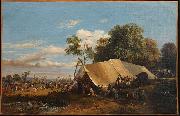 |
Theodore Ravanat -- Click Here
|
|
(born in Grenoble on 4 May 1812, died in Proveysieux on 21 September 1883) was a French landscape painter. Ravanat's work is mostly composed of Dauphine landscapes. His paintings are generally among private collections of Grenoble, but some of these paintings can be seen at the Museum of Grenoble or the Musee dauphinois. |
|
 |
Theodore R. Davis -- Click Here
|
|
1840 ?C 1894,was a 19th century American artist, who made numerous drawings of significant military and political events during the American Civil War and its aftermath. Some of these drawings include the Battle of Champion Hill, and the most significant sketch of General Joseph E. Johnston and General William T. Sherman meeting at the Bennett Farm near Durham Station to discuss the surrender terms of the remaining Confederate armies in the Southeast. After the war when the Cyclorama in Atlanta was being painted, Davis was asked for his ideas having traveled with Sherman's army. He was later added to the painting. |
|
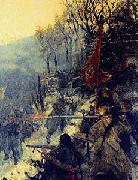 |
Theodor Rocholl -- Click Here
|
|
(1854-1933), German military painter and war artist.
Rocholl was born in Sachsenberg (Waldeck) on June 11, 1854, the son of Rudolf Rocholl, the Lutheran theologian and philosopher. He was a student in Munich in 1877, then at the Dresden Academy. After a year, he moved to Munich where he studied historical painting under Karl von Piloty. He ocmpleted his art studies at the Desseldorf Academy where he developed his interest in military art under the influence of Wilhelm Camphausen; his contemporaries in this field were Carl Röchling and Richard Knötel. The artist observed the Franco-Prussian War and the subsequent German army manoeuvres between 1883 and 1888; in 1890, he traveled to Russia to view the German Garde-Korps on manoeuvre. Later in the decade, he was attached to the Turkish Army and covered the conflict in Thessalia in 1897 between the Turks and the Greeks; his sketches of the fighting were published the following year. He covered the Boxer Rebellion in 1900 as the official artist of the German expeditionary force. A decade later, he covered the fighting between Turkey and Albania.
Many of his paintings depict German military scenes, especially the battles of the Franco-Prussian War. One of his most famous pictures depicted King William at the Battle of Sedan, meeting his triumphant soldiers after the victory. Rocholl also painted a large mural for the Evangelischen Padagogiums in Bad Godesberg.
In his 60th year, he became a war artist covering the campaign on the Western Front. His War Letters printed in 1916 in which he described the fear and destruction. An autobiography of his life as a painter appeared in 1921. He died in a streetcar accident Desseldorf in his 80th year on September 14, 1933.
|
|
 |
Theodoor Rombouts -- Click Here
|
|
Flemish , b. 1597, Antwerpen, d. 1637, Antwerpen
was a Flemish Baroque painter specializing in Caravaggesque genre scenes of card players and musicians. He studied under Abraham Janssens in Antwerp and was in Italy between 1616 and 1625, where he was heavily influenced by Caravaggio. |
|
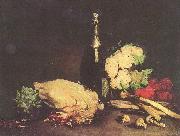 |
Theodhule-Augustin Ribot -- Click Here
|
|
painted Stilleben in 1865 |
|
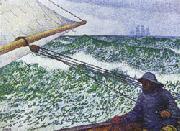 |
Theo Van Rysselberghe -- Click Here
|
|
Belgian Pointillist Painter, 1862-1926
was a Belgian neo-impressionist painter, who played a pivotal role in the European art scene at the turn of the century. Born in Ghent to a French-speaking bourgeois family, he studied first at the Academy of Ghent under Theo Canneel and from 1879 at the Academy of Brussels under the directorship of Jean-François Portaels. The North African paintings of Portaels had started an orientalist fashion in Belgium. Their impact would strongly influence the young Theo van Rysselberghe. Between 1882 and 1888 he made three trips to Morocco, staying there a total of one year and half. Barely 18 years old, he already participated at the Salon of Ghent, showing two portraits. Soon afterwards followed his Self-portrait with pipe (1880), painted in somber colours in the Belgian realistic tradition of that time. His Child in an open spot of the forest (1880) already departs from this style and he sets his first steps towards impressionism. |
|
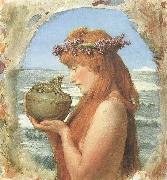 |
Sir Lawrence Alma-Tadema,OM.RA,RWS -- Click Here
|
|
1836-1912
|
|
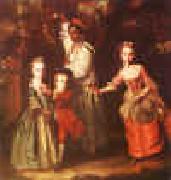 |
Sir Joshua Reynolds -- Click Here
|
|
British
1723-1792
Sir Joshua Reynolds Locations
Reynolds was born in Plympton, Devon, on 16 July 1723. As one of eleven children, and the son of the village school-master, Reynolds was restricted to a formal education provided by his father. He exhibited a natural curiosity and, as a boy, came under the influence of Zachariah Mudge, whose Platonistic philosophy stayed with him all his life.
Showing an early interest in art, Reynolds was apprenticed in 1740 to the fashionable portrait painter Thomas Hudson, with whom he remained until 1743. From 1749 to 1752, he spent over two years in Italy, where he studied the Old Masters and acquired a taste for the "Grand Style". Unfortunately, whilst in Rome, Reynolds suffered a severe cold which left him partially deaf and, as a result, he began to carry a small ear trumpet with which he is often pictured. From 1753 until the end of his life he lived in London, his talents gaining recognition soon after his arrival in France.
Reynolds worked long hours in his studio, rarely taking a holiday. He was both gregarious and keenly intellectual, with a great number of friends from London's intelligentsia, numbered amongst whom were Dr Samuel Johnson, Oliver Goldsmith, Edmund Burke, Giuseppe Baretti, Henry Thrale, David Garrick and fellow artist Angelica Kauffmann. Because of his popularity as a portrait painter, Reynolds enjoyed constant interaction with the wealthy and famous men and women of the day, and it was he who first brought together the famous figures of "The" Club.
With his rival Thomas Gainsborough, Reynolds was the dominant English portraitist of 'the Age of Johnson'. It is said that in his long life he painted as many as three thousand portraits. In 1789 he lost the sight of his left eye, which finally forced him into retirement. In 1791 James Boswell dedicated his Life of Samuel Johnson to Reynolds.
Reynolds died on 23 February 1792 in his house in Leicester Fields, London. He is buried in St. Paul's Cathedral. |
|
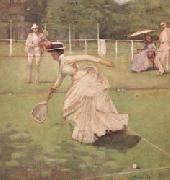 |
Sir John Lavery,RA -- Click Here
|
|
1856-1941
The artist John Lavery was born in Belfast, and studied in Scotland at the Glasgow School of Art from about 1874. He was in London from 1879-81 (he studied at Heatherley's School of Art for six months), and later in Paris, where he was influenced by Bastien-Lepage. He then returned to Glasgow, becoming a leading member of informal group of painters known as the Glasgow School (James Guthrie was another member), with work characterised by lack of a storyline, but great energy. Lavery achieved his pinnacle in the 1880s, with exhibitions in Europe and America, and as a leading portraitist, he was chosen to paint the State visit of Queen Victoria to the International Exhibition in Glasgow, 1888 - there were some 250 portraits in that picture. From 1890 he visited Morocco frequently, and he changed his British base to London in 1896, where he used a studio belonging to Alfred East. He was elected ARA in 1911, |
|
|
|
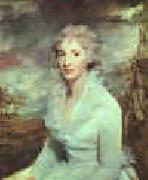 |
Sir Henry Raeburn -- Click Here
|
|
1756-1823
Scottish Sir Henry Raeburn Galleries
He was born the son of a manufacturer in Stockbridge, a former village now within the city of Edinburgh. Orphaned, he was supported by his older brother and placed in Heriot's Hospital, where he received an education. At the age of fifteen he was apprenticed to a goldsmith, and various pieces of jewellery, mourning rings and the like, adorned with minute drawings on ivory by his hand, still exist. Soon he took to the production of carefully finished portrait miniatures; meeting with success and patronage, he extended his practice to oil painting, at which he was self-taught. The goldsmith watched the progress of his pupil with interest, and introduced him to David Martin, who bad been the favourite assistant of Allan Ramsay the Latter, and was now the leading portrait painter in Edinburgh. Raeburn was especially aided by the loan of portraits to copy. Soon he had gained sufficient skill to make him decide to devote himself exclusively to painting.
In his early twenties, he was asked to paint the portrait of a young lady whom he had previously observed and admired when he was sketching from nature in the fields. She was the daughter of Peter Edgar of Bridgelands, and widow of Count Leslie. Fascinated by the handsome and intellectual young artist, she became his wife within a month, bringing him an ample fortune. The acquisition of wealth did not affect his enthusiasm or his industry, but spurred him on to acquire a thorough knowledge of his craft. It was usual for artists to visit Italy, and Raeburn set off with his wife. In London he was kindly received by Sir Joshua Reynolds, who advised him on what to study in Rome, especially recommending the works of Michelangelo. Raeburn carried with him to Italy many valuable introductions from the president of the Royal Academy. In Rome he met Gavin Hamilton, Pompeo Girolamo Batoni and Byers, an antique dealer whose advice proved particularly useful, especially the recommendation that "he should never copy an object from memory, but, from the principal figure to the minutest accessory, have it placed before him." After two years of study in Italy he returned to Edinburgh in 1787, and began a successful career as a portrait painter. In that year he executed a seated portrait of the second Lord President Dundas.
Raeburn's portrait of Sir Walter Scott (1822)Examples of his earlier portraiture include a bust of Mrs Johnstone of Baldovie and a three-quarter-length of Dr James Hutton, works which, if somewhat timid and tentative in handling and not as confident as his later work, nevertheless have delicacy and character. The portraits of John Clerk, Lord Eldin, and of Principal Hill of St Andrews belong to a later period. Raeburn was fortunate in the time in which he practised portraiture. Sir Walter Scott, Hugh Blair, Henry Mackenzie, Lord Woodhouselee, William Robertson, John Home, Robert Fergusson, and Dugald Stewart were resident in Edinburgh, and were all painted by Raeburn. Mature works include his own portrait and that of the Rev. Sir Henry Moncrieff Wellwood, the bust of Dr Wardrop of Torbane Hill, the two full-lengths of Adam Rolland]] of Gask, the remarkable paintings of Lord Newton and Dr Alexander Adam in the National Gallery of Scotland, and that of William Macdonald of St Martin's.
It was commonly believed that Raeburn was less successful in painting female portraits, but the exquisite full-length of his wife, the smaller likeness of Mrs R. Scott Moncrieff in the National Gallery of Scotland, and that of Mrs Robert Bell, and others, argue against this. Raeburn spent his life in Edinburgh, rarely visiting London, and then only for brief periods, thus preserving his individuality. Although he, personally, may have lost advantages resulting from closer association with the leaders of English art, and from contact with a wider public, Scottish art gained much from his disinclination to leave his native land. He became the acknowledged chief of the school which was growing up in Scotland during the earlier years of the 19th century, and his example and influence at a critical period were of major importance. So varied were his other interests that sitters used to say of him, "You would never take him for a painter till he seizes the brush and palette."
In 1812 he was elected president of the Society of Artists in Edinburgh, in 1814 associate, and in the following year full member of the Royal Scottish Academy. In 1822 he was knighted by George IV and appointed His Majesty's limner for Scotland. He died at Edinburgh.
The Reverend Robert Walker Skating on Duddingston Loch, better known as The Skating Minister (1790s)Raeburn had all the essential qualities of a popular and successful portrait painter. He was able to produce a telling and forcible likeness; his work is distinguished by powerful characterisation, stark realism, dramatic and unusual lighting effects, and swift and broad handling of the most resolute sort. David Wilkie recorded that, while travelling in Spain and studying the works of Diego Vel??zquez, the brushwork reminded him constantly of the "square touch" of Raeburn.
Raeburn was unusual amongst many of his contemporaries, such as Reynolds, in the extent of his philosophy of painting everything directly from life. This attitude partly explains the often coarse modelling and clashing colour combinations he employed, in contrast to the more refined style of Thomas Gainsborough and Reynolds. However these qualities and those mentioned above anticipate many of the later developments in painting of the nineteenth century from romanticism to Impressionism.
Sir Henry Raeburn died in St Bernard's House, Stockbridge, Edinburgh. |
|
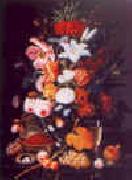 |
Severin Roesen -- Click Here
|
|
1848-1871
Severin Roesen (ca. 1815-1872) is a painter known for his abundant fruit and flower still lifes and is today recognized as one of the major American still-life painters of the mid-nineteenth century. Born in Cologne, in Germany, he emigrated to the United States in 1848.
While Roesen's paintings reveal a meticulous attention to detail in their precise arrangements and close brushwork, his subject matter, even down to specific motifs, did not change throughout his career. Sometimes he made near copies of paintings, but usually he merely rearranged and reassembled stock elements.
Numerous items in Fruit and Wine Glass, for example, also appear in other paintings. The footed desert plate full of strawberries is a common motif. The pilsner glass, sometimes accompanied by an open bottle of champagne, is interchangeable with a wine goblet filled with lemonade used elsewhere. The glass is nearly always placed at the lower left edge of the painting; a halved lemon often appears nearby. Branches full of grapes arranged from lower left to upper right provide the composition with a graceful S-curve and subtly lead the viewer's eye over the entire display. Here the composition is balanced by light and dark grapes at either side and filled in by scattered raspberries, cherries, peaches, apples, pears, and apricots. Many of these compositional elements, if not the items depicted, were derived from seventeenth-century Dutch still life paintings by such artists as Jan van Huysem. |
|
|
|
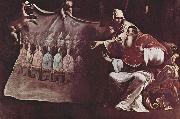 |
Sebastiano Ricci -- Click Here
|
|
(1 August 1659 - 15 May 1734) was an Italian painter of the late Baroque school of Venice. About the same age as Piazzetta, and an elder contemporary of Tiepolo, he represents a late version of the vigorous and luminous Cortonesque style of grand manner fresco painting.
He was born in Belluno, son of Andreana and Livio Ricci. In 1671, he apprenticed to Federico Cerebri of Venice. Others claim Ricci's first master was Sebastiano Mazzoni. In 1678, a youthful indiscretion led to an unwanted pregnancy, and ultimately to a greater scandal, when Ricci was accused of attempting to poison the young pregnant woman to avoid marriage. Imprisoned, he gained release only after intervention of a nobleman, probably a Pisani family member. He married the pregnant mother in 1691, although this was a stormy union.
After his arrest, he moved to Bologna, where he domiciled near the Parish of San Michele del Mercato. His painting style there was apparently influenced by Giovanni Gioseffo dal Sole. On 28 September 1682 he was contracted by the "Fraternity of Saint John of Florence" to paint a Decapitation of John the Baptist for their Oratory. On 9 December 1685, the Count of San Segundo near Parma commissioned from Ricci the decoration of the Oratory of the Madonna of the Seraglio, which he completed in collaboration of Ferdinando Galli-Bibiena by October 1687, receiving a compensation of 4,482 Lira. |
|
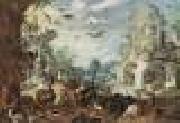 |
SAVERY, Roelandt -- Click Here
|
|
Flemish Northern Renaissance Painter, 1576-1639
Flemish Northern Renaissance Painter, 1576-1639.Painter, draughtsman and etcher, brother of (1) Jacob Savery I. The subject and miniaturist precision of his earliest dated work, Birds by a Pond (1600; St Petersburg, Hermitage), reflect the influence of Jacob, his presumed teacher. The strong Flemish current in Amsterdam c. 1600 is apparent in the Village Edge |
|
 |
Sanford Robinson Gifford -- Click Here
|
|
1823-1880
Sanford Robinson Gifford (July 10, 1823 ?C August 29, 1880) was an American landscape painter and one of the leading members of the Hudson River School. Gifford's landscapes are known for their emphasis on light and soft atmospheric effects, and he is regarded as a practitioner of Luminism, an offshoot style of the Hudson River School.
Returning to his studio in New York City, Gifford painted numerous major landscapes from scenes he recorded on his travels. Gifford's method of creating a work of art was similar to other Hudson River School artists. He would first sketch rough, small works in oil paint from his sketchbook pencil drawings. Those scenes he most favored he then developed into small, finished paintings, then into larger, finished paintings. |
|
|
|
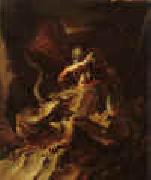 |
Salvator Rosa -- Click Here
|
|
1615-1673
Italian
Salvator Rosa Galleries
Salvatore Rosa (1615 - March 15, 1673) was an Italian Baroque painter, poet and printmaker, active in Naples, Rome and Florence. As a painter, he is best known as an "unorthodox and extravagant" and a "perpetual rebel" proto-Romantic. His life and writings were equally colorful.
He continued apprenticeship with Falcone, helping him complete his battlepiece canvases. In that studio, it is said that Lanfranco took notice of his work, and advised him to relocate to Rome, where he stayed from 1634-6.
Returning to Naples, he began painting haunting landscapes, overgrown with vegetation, or jagged beaches, mountains, and caves. Rosa was among the first to paint "romantic" landscapes, with a special turn for scenes of picturesque often turbulent and rugged scenes peopled with shepherds, brigands, seamen, soldiers. These early landscapes were sold cheaply through private dealers. This class of paintings peculiarly suited him.
He returned to Rome in 1638-39, where he was housed by Cardinal Francesco Maria Brancaccio, bishop of Viterbo. For the Chiesa Santa Maria della Morte in Viterbo, Rosa painted his first and one of his few altarpieces with an Incredulity of Thomas.
While Rosa had a facile genius at painting, he pursued a wide variety of arts: music, poetry, writing, etching, and acting. In Rome, he befriended Pietro Testa and Claude Lorraine. During a Roman carnival play he wrote and acted in a masque, in which his character bustled about Rome distributing satirical prescriptions for diseases of the body and more particularly of the mind. In costume, he inveighed against the farcical comedies acted in the Trastevere under the direction of Bernini.
While his plays were successful, this also gained him powerful enemies among patrons and artists, including Bernini himself, in Rome. By late 1639, he had had to relocate to Florence, where he stayed for 8 years. He had been in part, invited by a Cardinal Giancarlo de Medici. Once there, Rosa sponsored a combination of studio and salon of poets, playwrights, and painters --the so called Accademia dei Percossi ("Academy of the Stricken"). To the rigid art milieu of Florence, he introduced his canvases of wild landscapes; while influential, he gathered few true pupils. Another painter poet, Lorenzo Lippi, shared with Rosa the hospitality of the cardinal and the same circle of friends. Lippi encouraged him to proceed with the poem Il Malmantile Racquistato. He was well acquainted also with Ugo and Giulio Maffei, and housed with them in Volterra, where he wrote four satires Music, Poetry, Painting and War. About the same time he painted his own portrait, now in the National Gallery, London. |
|
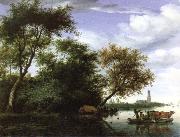 |
Salomon van Ruysdael -- Click Here
|
|
Salomon van Ruysdael (c. 1602, Naarden - buried Nov 3, 1670, Haarlem) was a Dutch landscape painter. He was the uncle of Jacob van Ruisdael. |
|
 |
Salomon Rombouts -- Click Here
|
|
Dutch Baroque Era Painter, ca.1650-1702 |
|
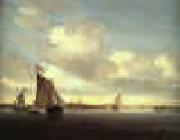 |
Saloman van Ruysdael -- Click Here
|
|
1600-1670
Dutch
Saloman van Ruysdael Gallery |
|
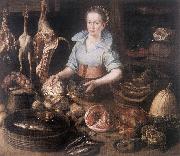 |
RYCK, Pieter Cornelisz van -- Click Here
|
|
Dutch painter (b. 1568, Delft, d. 1628, Haarlem).
|
|
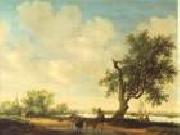 |
RUYSDAEL, Salomon van -- Click Here
|
|
Dutch Baroque Era Painter, ca.1600-1670.
Dutch painter. He is best known for his atmospheric, almost monochromatic, river scenes, painted in the 1630s during the 'tonal phase' of Dutch art. His work in this genre is very close in style to that of Jan van Goyen, and their paintings have often been confused. |
|
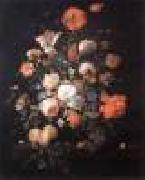 |
RUYSCH, Rachel -- Click Here
|
|
Dutch Baroque Era Painter, 1664-1750
Dutch painter. She specialized in still-lifes of flowers and fruits and still-lifes in outdoor settings, the large majority signed, with dated examples from 1681 to 1747 providing a sound chronology. She is widely regarded as the most gifted woman in the history of the subject and among the greatest exponents of either sex. Ruysch came from a distinguished and wealthy background. Her father, Frederik Ruysch (1638-1731), was an eminent professor of anatomy and botany, who published his fine collection of natural curiosities. He was also a gifted amateur painter. Her mother was the daughter of the architect Pieter Post. At the age of 15 Ruysch became a pupil of Willem van Aelst until his death in 1683. In 1693 she married the portrait painter Juriaen Pool (1665-1745), a happy union that produced ten children. In 1709 the couple moved to The Hague, where both artists joined the Guild of St Luke. From 1708 to 1713 they were both court painters to the Elector Palatine, John William, at D?sseldorf, for whom they continued to work until his death in 1716. In that year they returned to Amsterdam, where Ruysch continued working until at least the age of 83. |
|
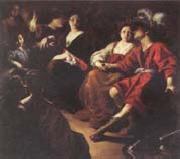 |
Rutilio Manetti -- Click Here
|
|
Italian Baroque Era Painter ,
1571 - 1639
was an Italian painter of late-Mannerism or proto-Baroque, active mainly in Siena. He was influenced and/or taught by the local artists Francesco Vanni and Ventura Salimbeni. He is known to have collaborated with Raffaele Vanni, the son of Francesco. He is known for the following works in Siena or nearby towns: Story of St Catherine and Pope Gregory (1597; Palazzo Pubblico), Baptism of Christ (1600; San Giovannino in Pantaneto); a fresco cycle of the Story of St Roch (1605-1610; San Rocco alla Lupa), Pope Alexander I freed from prison by an Angel from San Giovanni Battista in Sant'Ansano in Greti; a Temptation of Saint Anthony (1620, Sant'Agostino), a Death of Blessed Antonino Patrizi (Monticiano, 1616), a Blessed Domenico dal Pozzo at the table now in Certosa of Florence, a Birth of Virgin (1625, Church of Santa Maria dei Servi), and a painting (1628, Church of San Domenico). He painted a remarkable Allegory of the four seasons and a Parable of the blind men, now in private collections. He also contributed to the Casino Mediceo His style moved from one derived from Barocci to a more Caravaggesque manner after the first decade of the 1600s. |
|
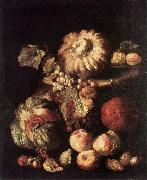 |
RUOPPOLO, Giovanni Battista -- Click Here
|
|
Italian Baroque Era Painter, 1629-ca.1690 |
|
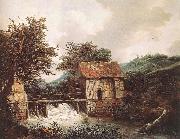 |
RUISDAEL, Jacob Isaackszon van -- Click Here
|
|
Dutch Baroque Era Painter, ca.1628-1682 |
|
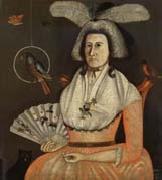 |
Rufus Hathaway -- Click Here
|
|
American country painter , 1770-1822
American painter and physician. He may have been apprenticed to ship-carvers and decorators, but he was not trained in fine art. His earliest known portrait, Lady with her Pets (1790; New York, Met.), demonstrates his unsophisticated, decorative style. Between 1790 and 1796 he seems to have worked as an itinerant artist; only portraits of relatives and friends survive. During his life he painted at least 25 portraits as well as miniatures, views and decorative overmantels. He also painted a genre subject, the Welch Curate, c. 1800 |
|
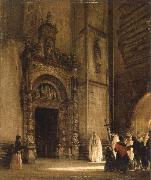 |
rudolph von alt -- Click Here
|
|
Rudolf Ritter von Alt (28 August 1812 in Vienna ?C 12 March 1905 in Vienna) was an Austrian landscape and architectural painter. Borne as Rudolf Alt, he could call himself von Alt and bear the title of a Ritter (knight) after he gained nobility in 1882.
He was the son of the famous lithographer Jakob Alt (1789-1872). He studied at the Akademie der bildenden K??nste in Vienna. Hiking-trips through the Austrian Alps and northern Italy awoke a love for landscapes, and he painted with his brush using watercolors in a very realistic and detailed style. In 1833, inspired by a visit to Venice and neighbouring cities, he also made a number of architectural paintings.
Alt demonstrated a remarkable talent for expressing certain peculiarities in nature. He managed to paint nature authentically by focusing on the different hues of sky, the colour-tone of the air and the vegetation. His later works came closer to Impressionism. His perspectives on architecture were interesting, and he often chose everyday objects to paint. The painting of interior-views also became one of his strong points, giving him attention in Vienna.
He visited and worked for a while in Rome and Naples; after that he visited the lakes of Lombardy, then Galicia, Bohemia, Dalmatia, Bavaria and then returned multiple times to Italy. In 1863 he went to the Crimea to paint some views of an estate of the Empress, and in 1867 he went to Sicily.
His younger brother Franz Alt, (b. 1821 in Vienna) was also a painter.
Most of his paintings are held by various museums in Vienna. The Albertina in Vienna hosted a retrospective exhibition from September 2005 to January 2006.
|
|
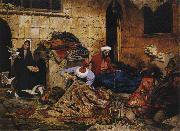 |
Rudolph Swoboda -- Click Here
|
|
Austrian, 1859 - 1914 |
|
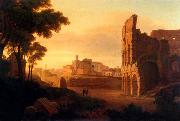 |
Rudolf Wiegmann -- Click Here
|
|
painted Rom, Colosseum and the Roman Forum in 1835 |
|
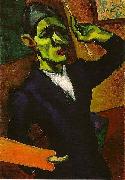 |
Rudolf Wacker -- Click Here
|
|
Austria (1893 -1939 ) - Painter
painted Selbstbildnis mit orangefarbener Palette in 1926 |
|
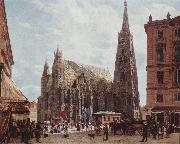 |
Rudolf von Alt -- Click Here
|
|
(28 August 1812 in Vienna C 12 March 1905 in Vienna) was an Austrian landscape and architectural painter. Borne as Rudolf Alt, he could call himself von Alt and bear the title of a Ritter (knight) after he gained nobility in 1882.
He was the son of the famous lithographer Jakob Alt (1789-1872). He studied at the Akademie der bildenden K??nste in Vienna. Hiking-trips through the Austrian Alps and northern Italy awoke a love for landscapes, and he painted with his brush using watercolors in a very realistic and detailed style. In 1833, inspired by a visit to Venice and neighbouring cities, he also made a number of architectural paintings.
Alt demonstrated a remarkable talent for expressing certain peculiarities in nature. He managed to paint nature authentically by focusing on the different hues of sky, the colour-tone of the air and the vegetation. His later works came closer to Impressionism. His perspectives on architecture were interesting, and he often chose everyday objects to paint. The painting of interior-views also became one of his strong points, giving him attention in Vienna. |
|
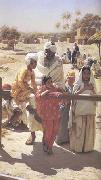 |
Rudolf Swoboda -- Click Here
|
|
1859 - 1914
was a 19th-century Austrian painter, born in Vienna. He studied under Leopold Carl M??ller, and voyaged with him to Egypt in 1880. He was a well-known Orientalist. In 1886, Queen Victoria commissioned Swoboda to paint several of a group of Indian artisans who had been brought to Windsor as part of the Golden Jubilee preparations. Victoria liked the resulting paintings so much that she paid Swoboda's way to India to paint more of her Indian subjects.Swoboda painted many of the ordinary people of India in a grouping of small (no more than eight inches high) paintings which resulted. While in India, he stayed, part of the time, with John Lockwood Kipling, and met his son Rudyard Kipling. The younger Kipling was unimpressed with Swoboda, writing to a friend about two "Austrian maniacs" who thought they were "almighty" artists aiming to "embrace the whole blazing East".Upon his return from India, he also painted (in 1888 and 1889) two portraits of Abdul Karim, |
|
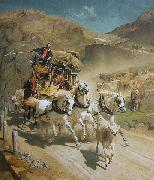 |
Rudolf Koller -- Click Here
|
|
Rudolf Koller (1828-1905) was a Swiss painter. |
|
|
|
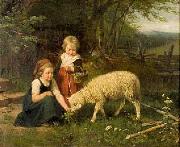 |
Rudolf Epp -- Click Here
|
|
Rudolf Epp , painter (1834-1910) |
|
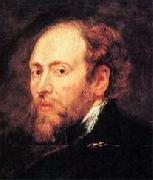 |
RUBENS, Pieter Pauwel -- Click Here
|
|
Flemish Baroque Era Painter, 1577-1640 |
|
|
|
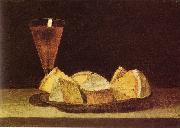 |
Rubens Peale -- Click Here
|
|
Rubens Peale (May 4, 1784 - July 17, 1865) was an American artist and museum director. Born in Philadelphia, he was a son of artist-naturalist, Charles Willson Peale.
|
|
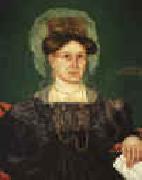 |
Royall Brewster Smith -- Click Here
|
|
1801-1855
Royall Brewster Smith Gallery |
|
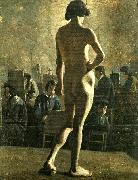 |
royal academy -- Click Here
|
|
unknown artist, mid 19th century |
|
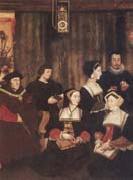 |
Rowland Lockey -- Click Here
|
|
English Baroque Era Painter, ca.1565-1616,was an English painter and goldsmith. The son of Leonard Lockey, a crossbow maker of the parish of St Bride's, Fleet Street, London, Lockey was apprenticed to Queen Elizabeth's miniaturist and goldsmith Nicholas Hilliard for eight years beginning Michaelmas 1581[1] and was made a freeman or master of the Worshipful Company of Goldsmiths by 1600. He worked mainly as a copyist of earlier portraits to make up sets of oil paintings for the fashionable long galleries of great houses, but signed or documented portrait miniatures on vellum and a signed title page engraving for the 1602 Bishops' Bible also survive. |
|
|
|
|
|
|
| | |
|
|
|
|